How to spot scams like Your Password Expires Today email scam
Phishing/ScamAlso Known As: Your Password Expires Today phishing email
Get free scan and check if your device is infected.
Remove it nowTo use full-featured product, you have to purchase a license for Combo Cleaner. Seven days free trial available. Combo Cleaner is owned and operated by RCS LT, the parent company of PCRisk.com.
What kind of scam is "Your Password Expires Today"?
We have examined this email and found that it is disguised as a letter from Microsoft regarding account password expiry. It contains a hyperlink that opens various untrustworthy websites (phishing pages, download sites for shady software, etc.). The actual Microsoft company has nothing to do with this email. Thus, it must be ignored.
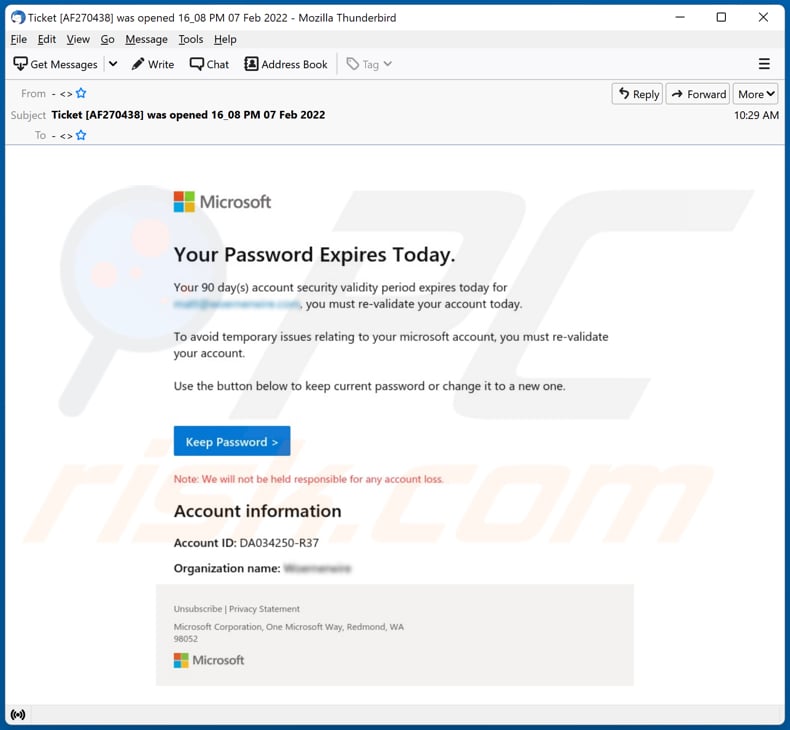
"Your Password Expires Today" email scam in detail
The email contains a Microsoft logo, a "Keep Password" hyperlink, fake account ID, organization name. It claims that the account security validity period (for the recipient's email address) expires today. The purpose of this email is to trick visitors into believing that they must re-validate the Microsoft account using the provided hyperlink.
We have found that the "Keep Password" hyperlink opens cracked software download sites, various phishing pages, download pages for shady applications, etc. Downloading files/software from the pages opened via the presented link and providing information on those pages can lead to computer infections, financial losses, identity theft, or other issues.
| Name | Your Password Expires Today Email Scam |
| Threat Type | Phishing, Scam, Social Engineering, Fraud |
| Fake Claim | Microsoft account password is about to expire |
| Related Domain | vadesecure[.]com, siasky[.]net |
| Detection Names (vadesecure[.]com) | CRDF (Malicious), Full List Of Detections (VirusTotal) |
| Serving IP Address (vadesecure[.]com) | 185.187.30.4 |
| Disguise | Letter from Microsoft |
| Symptoms | Unauthorized online purchases, changed online account passwords, identity theft, illegal access of the computer. |
| Distribution methods | Deceptive emails, rogue online pop-up ads, search engine poisoning techniques, misspelled domains. |
| Damage | Loss of sensitive private information, monetary loss, identity theft. |
| Malware Removal (Windows) |
To eliminate possible malware infections, scan your computer with legitimate antivirus software. Our security researchers recommend using Combo Cleaner. Download Combo CleanerTo use full-featured product, you have to purchase a license for Combo Cleaner. 7 days free trial available. Combo Cleaner is owned and operated by RCS LT, the parent company of PCRisk.com. |
Emails of this type in general
Typically, emails of this type are disguised as important/official/urgent letters from legitimate companies, institutions, or other entities. They encourage recipients to open the presented links (or attachments) and provide sensitive information. Scammers behind them attempt to obtain credit card details, account login credentials, and other personal details.
Examples of similar emails are "Signed In To From A New Windows Device Email Scam", "Request To Close Your Email Scam", "DHL Shipment Details Email Scam". Cybercriminals can use emails not only to extract sensitive information but also to deliver malware.
How do spam campaigns infect computers?
Emails used to distribute malware contain website links or attachments. The purpose of such emails is to trick recipients into executing malware (downloading and opening malicious files). Examples of files that threat actors use to deliver malware are PDF, Microsoft Office, other documents, archives, executables, JavaScript, and other files.
How to avoid installation of malware?
Always examine emails received from unknown or suspicious addresses. Especially the irrelevant ones containing links or attachments. It is very popular among threat actors to use email to distribute malware. Furthermore, avoid downloading opening files downloaded from questionable sources.
Download software and files from official pages. Do not use third-party tools to activate or update the installed software. Always use functions/tools provided by the official developers when willing to update or activate the software. If you've already opened malicious attachments, we recommend running a scan with Combo Cleaner Antivirus for Windows to automatically eliminate infiltrated malware.
The appearance of the "Your Password Expires Today" email (GIF):
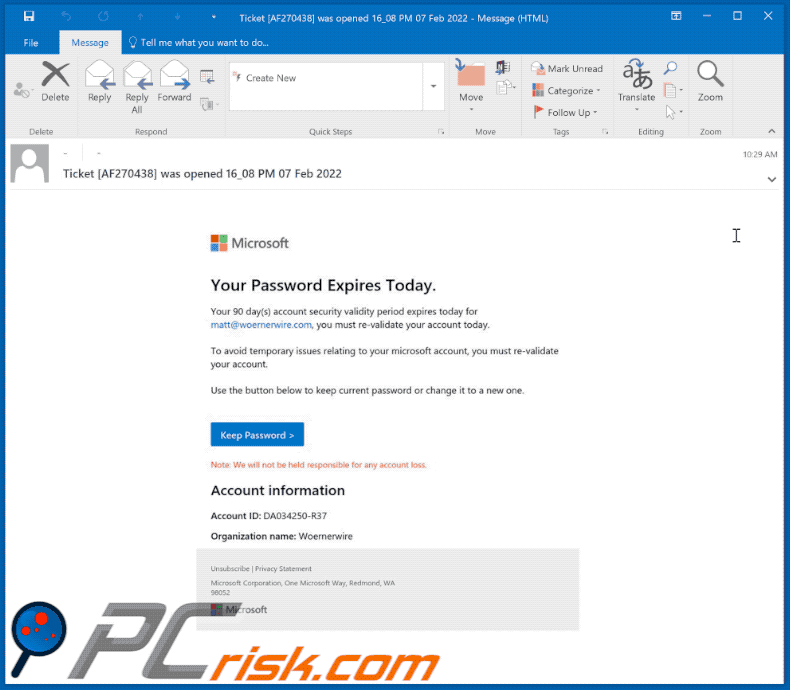
Text in the email:
Subject: Ticket [AF270438] was opened 16_08 PM 07 Feb 2022
MicrosoftYour Password Expires Today
Your 90 day(s) account security validity period expires today for *******, you must re-validate your account today.
To avoid temporary issues relating to your microsoft account, you must re-validate your account.
Use the button below to keep current password or change it to a new one.
Keep Password>
Note: We will not be held responsible for any account loss.
Account information
Account ID: DA034250-R37
Organization name: -Unsubscribe | Privacy Statement
Microsoft Corporation, One Microsoft Way, Redmond, WA 98052
Microsoft
Another example of password expiration-themed spam email promoting a phishing site:
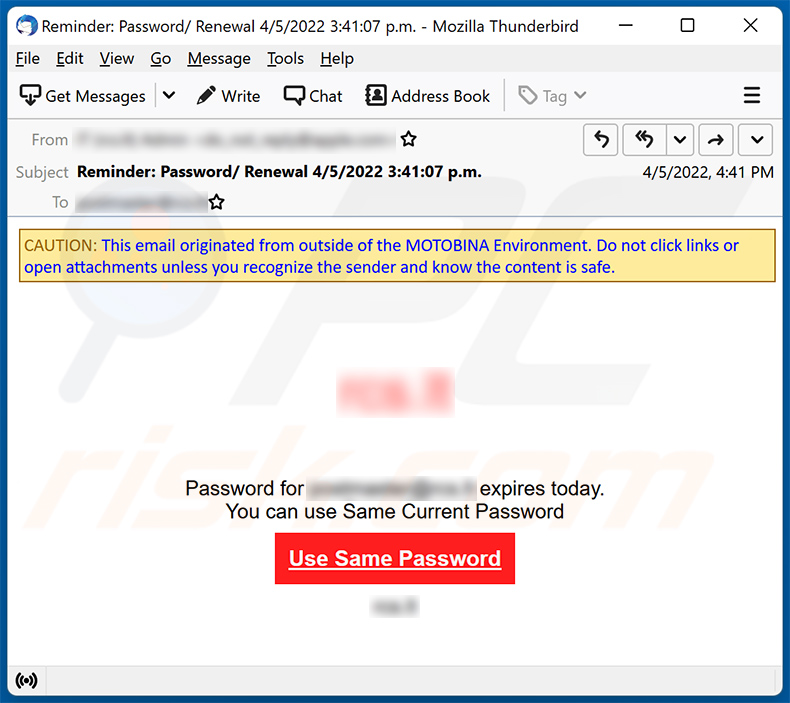
Text presented within:
Subject: Reminder: Password/ Renewal 4/5/2022 3:41:07 p.m.
CAUTION: This email originated from outside of the MOTOBINA Environment. Do not click links or open attachments unless you recognize the sender and know the content is safe.
********
Password for ******** expires today.
You can use Same Current Password
Use Same Password********
Screenshot of the promoted phishing site:
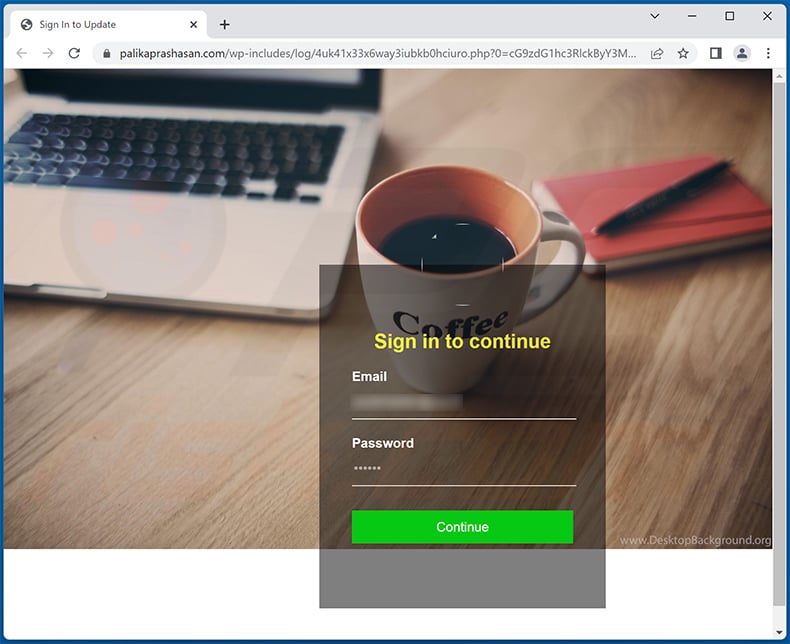
Another example of password expiration-themed spam email promoting a phishing site:
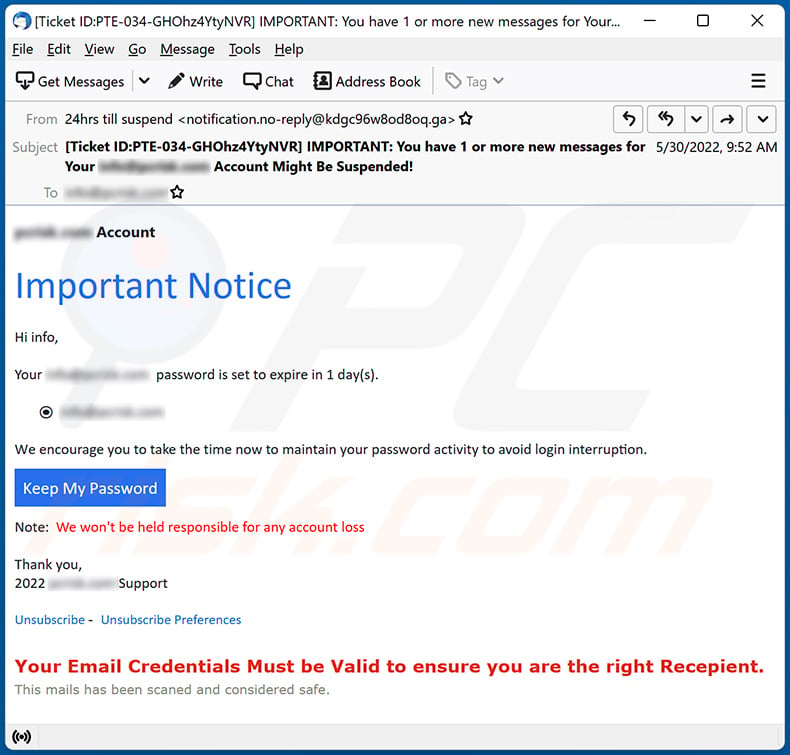
Text presented within:
Subject: [Ticket ID:PTE-034-GHOhz4YtyNVR] IMPORTANT: You have 1 or more new messages for Your - Account Might Be Suspended!
- Account
Important Notice
Hi -,
Your - password is set to expire in 1 day(s).
-
We encourage you to take the time now to maintain your password activity to avoid login interruption.
Keep My Password
Note: We won't be held responsible for any account loss
Thank you,
2022 - SupportUnsubscribe - Unsubscribe Preferences
Your Email Credentials Must be Valid to ensure you are the right Recepient.
This mails has been scaned and considered safe.
Screenshot of the promoted phishing site:
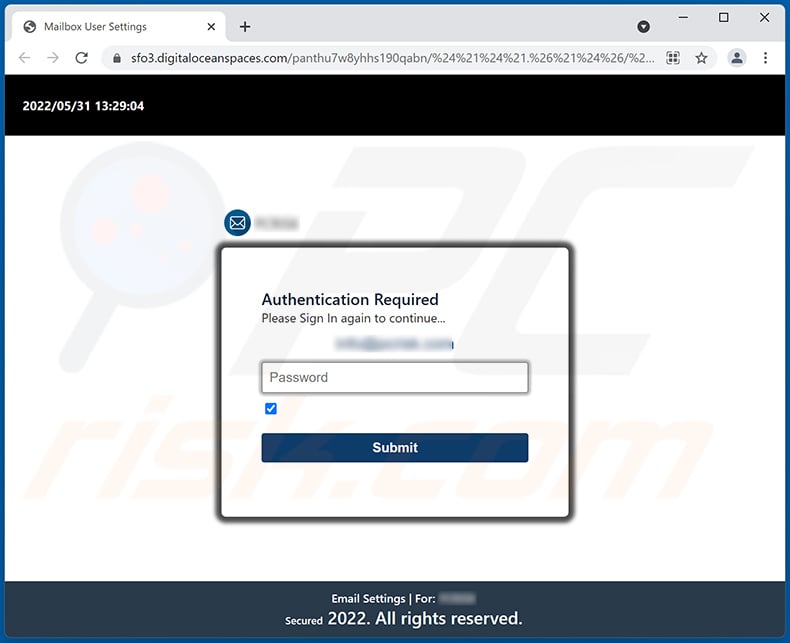
Another example of password expiration-themed spam email promoting a phishing site:
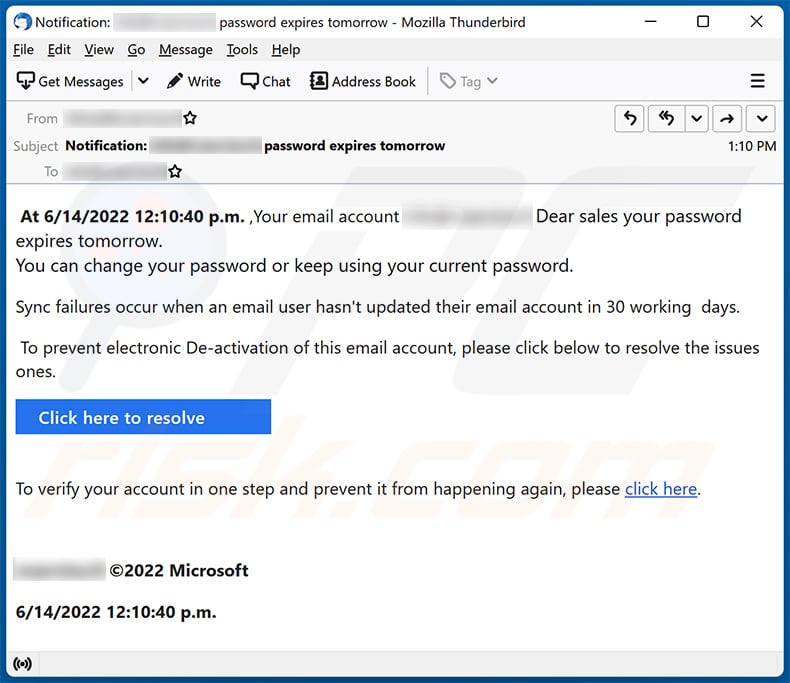
Text presented within:
Subject: Notification: ******** password expires tomorrow
At 6/14/2022 12:10:40 p.m. ,Your email account ******** Dear sales your password expires tomorrow.
You can change your password or keep using your current password.Sync failures occur when an email user hasn't updated their email account in 30 working days.
To prevent electronic De-activation of this email account, please click below to resolve the issues ones.
Click here to resolve
To verify your account in one step and prevent it from happening again, please click here.
******** ©2022 Microsoft
6/14/2022 12:10:40 p.m.
Screenshot of the promoted phishing site:
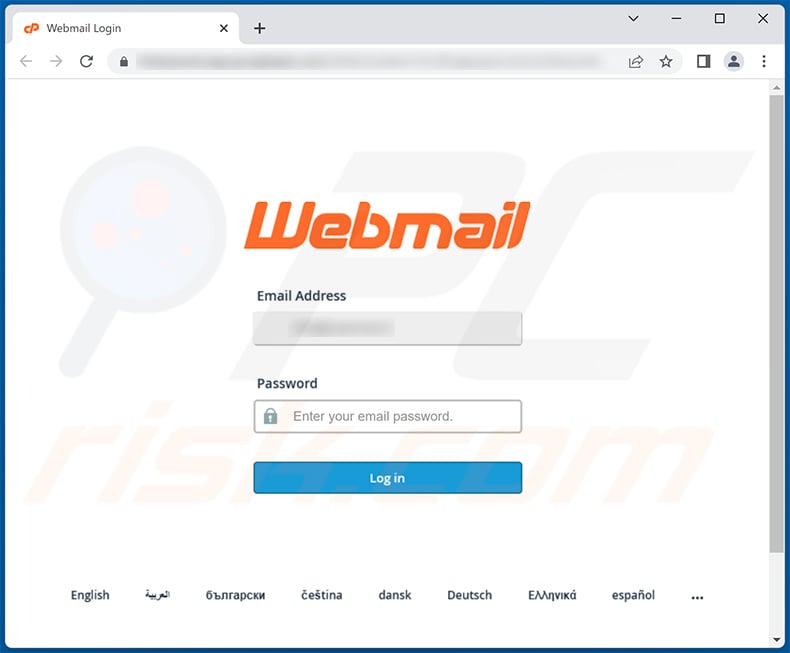
Yet another example of password expiration-themed spam email promoting a phishing site:
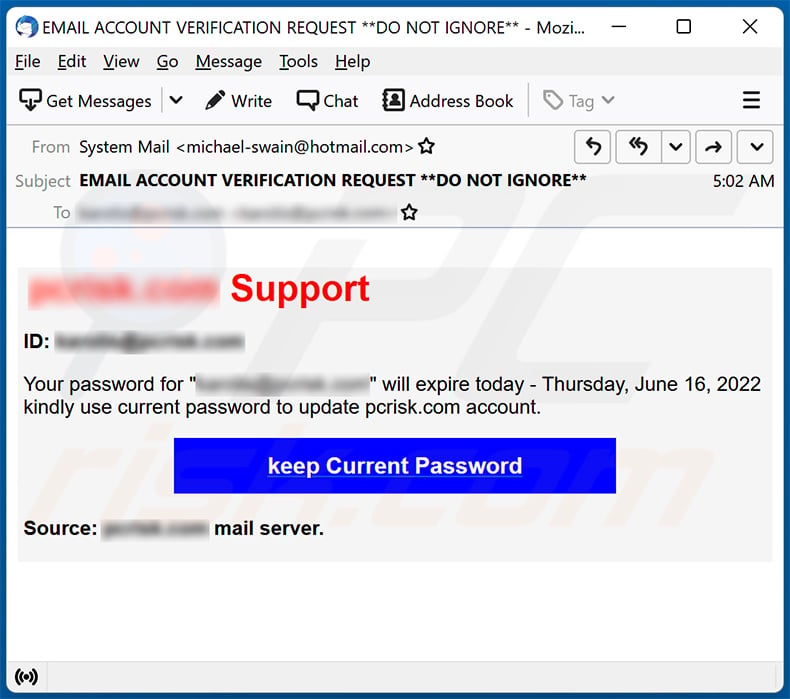
Text presented within:
Subject: EMAIL ACCOUNT VERIFICATION REQUEST **DO NOT IGNORE**
******** Support
ID: ********
Your password for "********" will expire today - Thursday, June 16, 2022
kindly use current password to update ******** account.
keep Current Password
Source: ******** mail server.
Screenshot of the promoted phishing site:
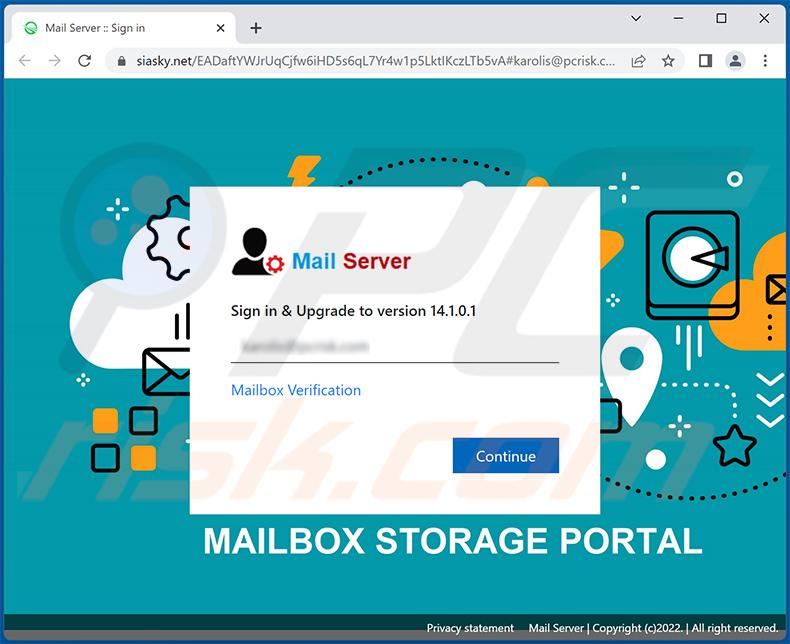
Another example of password expiration-themed spam email promoting a phishing site:
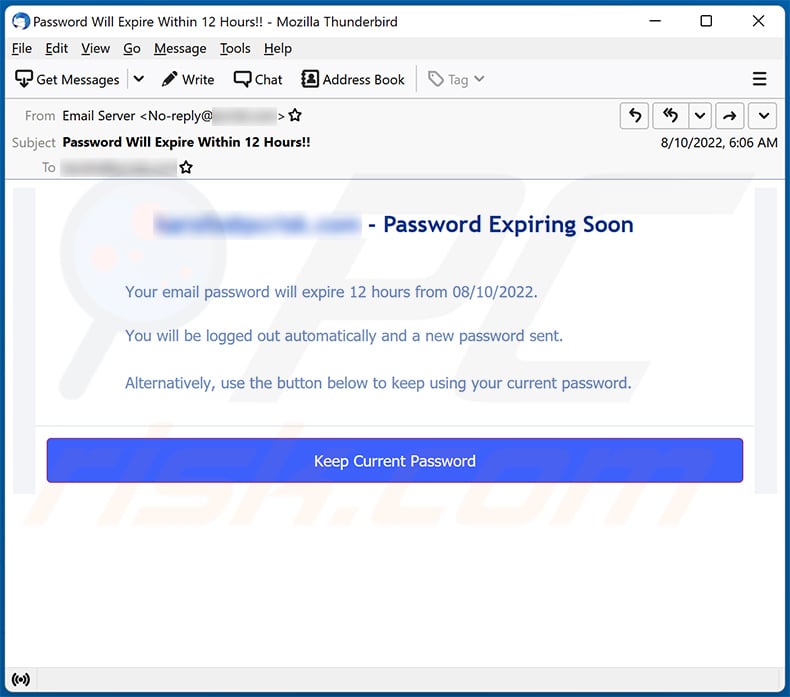
Text presented within:
Subject: Password Will Expire Within 12 Hours!!
- - Password Expiring Soon
Your email password will expire 12 hours from 08/10/2022.
You will be logged out automatically and a new password sent.
Alternatively, use the button below to keep using your current password.
Keep Current Password
Screenshot of the promoted phishing site:
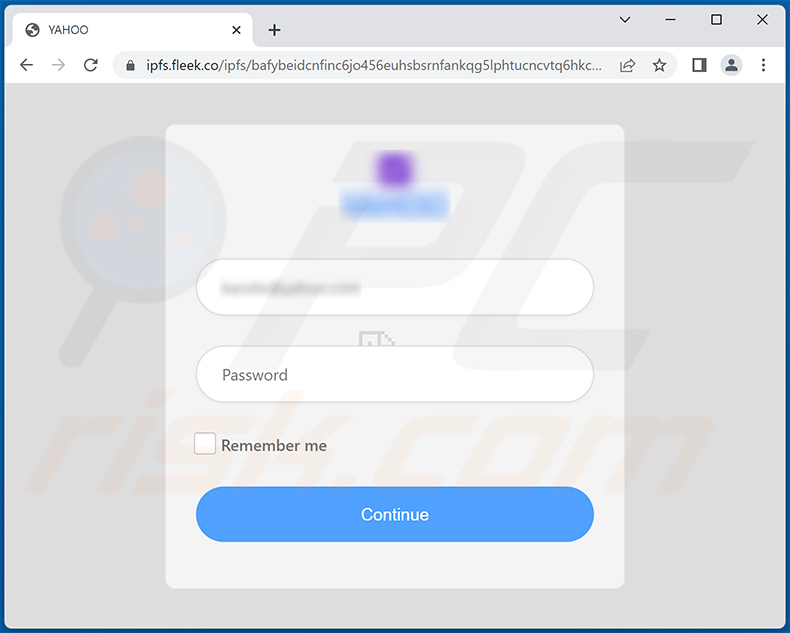
Yet another example of password expiration-themed spam email:
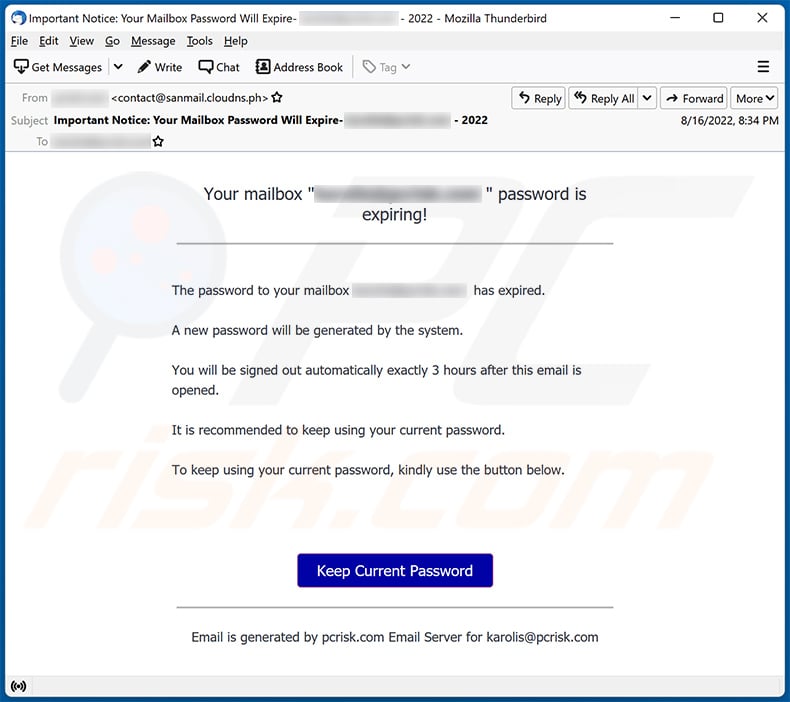
Text presented within:
Subject: Important Notice: Your Mailbox Password Will Expire- ******** - 2022
Your mailbox "******** " password is expiring!
The password to your mailbox ******** has expired.
A new password will be generated by the system.
You will be signed out automatically exactly 3 hours after this email is opened.
It is recommended to keep using your current password.
To keep using your current password, kindly use the button below.
Keep Current Password
Email is generated by ******** Email Server for ********
Screenshot of the promoted phishing site:
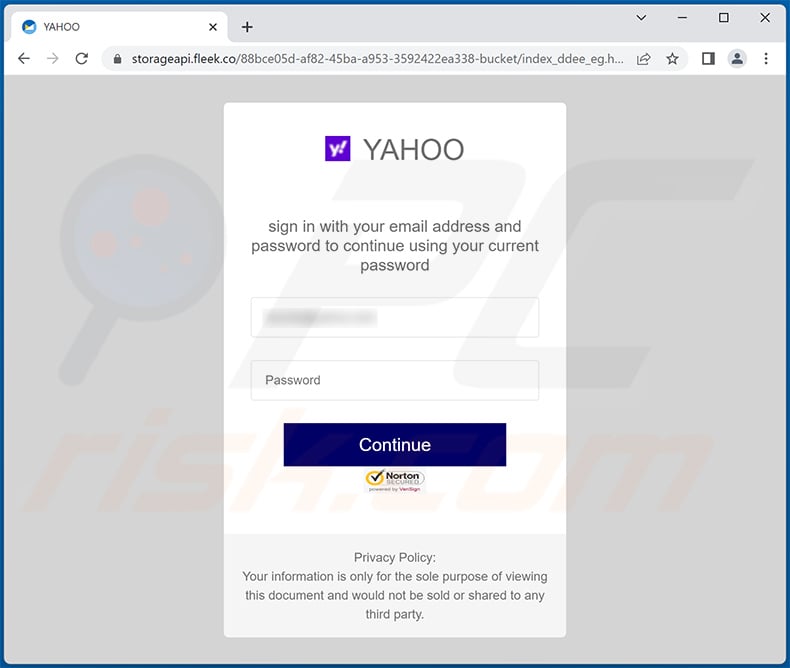
Yet another example of password expiration-themed spam email promoting a phishing site:
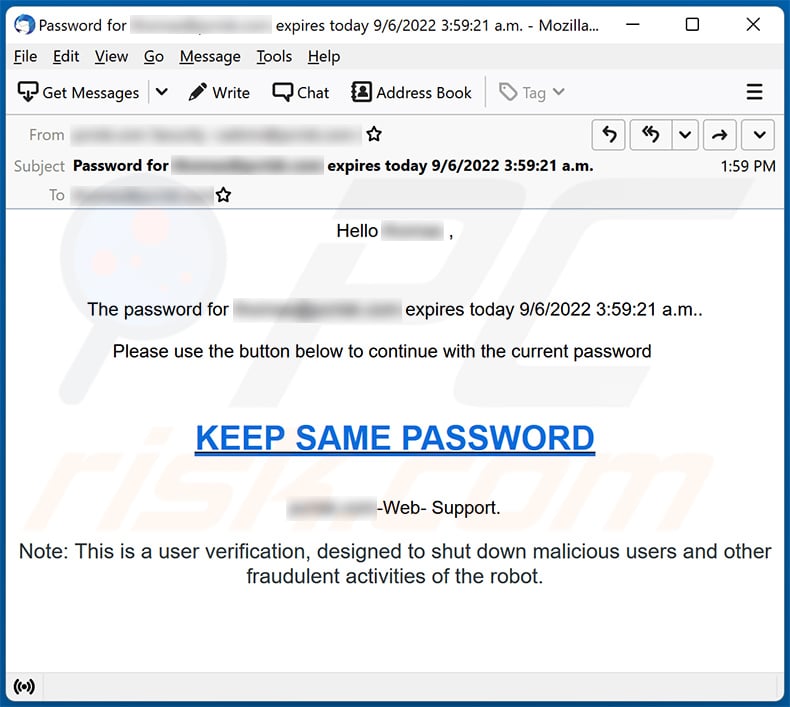
Text presented within:
Subject: Password for ******** expires today 9/6/2022 3:59:21 a.m.
Hello ******** ,
The password for ******** expires today 9/6/2022 3:59:21 a.m..
Please use the button below to continue with the current password
KEEP SAME PASSWORD
********-Web- Support.
Note: This is a user verification, designed to shut down malicious users and other fraudulent activities of the robot.
Screenshot of the promoted phishing site:
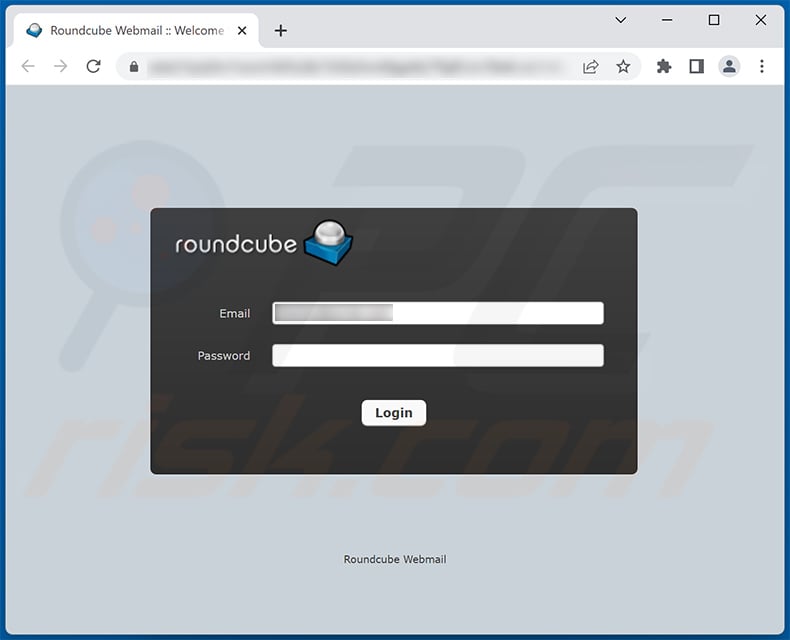
A Spanish variant of an email from "Your Password Expires Today" spam campaign:
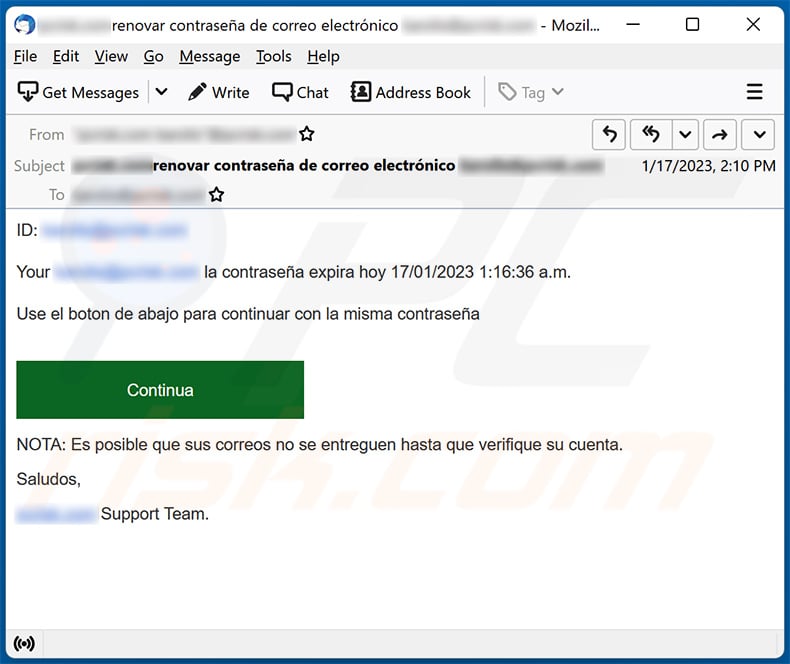
Text presented within:
Subject: ********renovar contraseña de correo electrónico ********
ID: ********
Your ******** la contraseña expira hoy 17/01/2023 1:16:36 a.m.
Use el boton de abajo para continuar con la misma contraseña
Continua
NOTA: Es posible que sus correos no se entreguen hasta que verifique su cuenta.
Saludos,
******** Support Team.
Screenshot of the promoted phishing site imitating the user's email service provider:
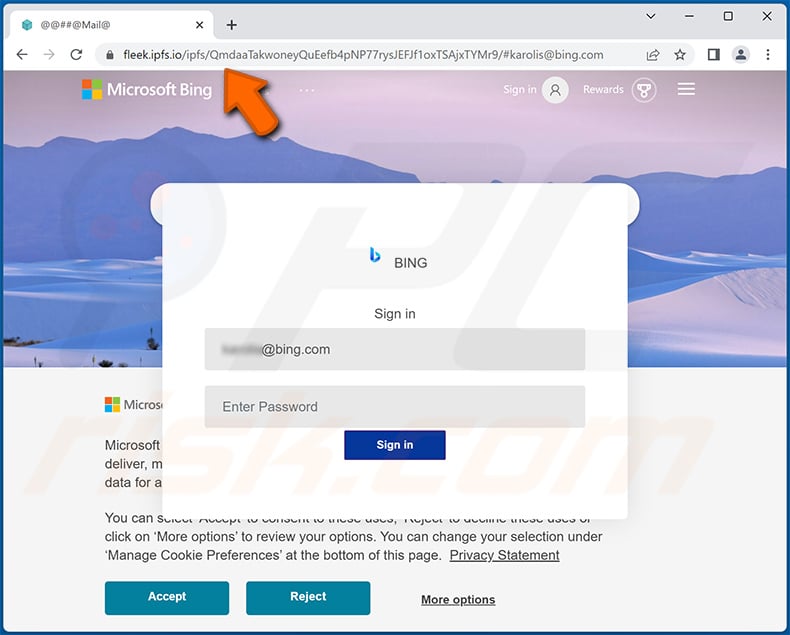
Instant automatic malware removal:
Manual threat removal might be a lengthy and complicated process that requires advanced IT skills. Combo Cleaner is a professional automatic malware removal tool that is recommended to get rid of malware. Download it by clicking the button below:
DOWNLOAD Combo CleanerBy downloading any software listed on this website you agree to our Privacy Policy and Terms of Use. To use full-featured product, you have to purchase a license for Combo Cleaner. 7 days free trial available. Combo Cleaner is owned and operated by RCS LT, the parent company of PCRisk.com.
Quick menu:
- What is Your Password Expires Today phishing email?
- Types of malicious emails.
- How to spot a malicious email?
- What to do if you fell for an email scam?
Types of malicious emails:
![]() Phishing Emails
Phishing Emails
Most commonly, cybercriminals use deceptive emails to trick Internet users into giving away their sensitive private information, for example, login information for various online services, email accounts, or online banking information.
Such attacks are called phishing. In a phishing attack, cybercriminals usually send an email message with some popular service logo (for example, Microsoft, DHL, Amazon, Netflix), create urgency (wrong shipping address, expired password, etc.), and place a link which they hope their potential victims will click on.
After clicking the link presented in such email message, victims are redirected to a fake website that looks identical or extremely similar to the original one. Victims are then asked to enter their password, credit card details, or some other information that gets stolen by cybercriminals.
![]() Emails with Malicious Attachments
Emails with Malicious Attachments
Another popular attack vector is email spam with malicious attachments that infect users' computers with malware. Malicious attachments usually carry trojans that are capable of stealing passwords, banking information, and other sensitive information.
In such attacks, cybercriminals' main goal is to trick their potential victims into opening an infected email attachment. To achieve this goal, email messages usually talk about recently received invoices, faxes, or voice messages.
If a potential victim falls for the lure and opens the attachment, their computers get infected, and cybercriminals can collect a lot of sensitive information.
While it's a more complicated method to steal personal information (spam filters and antivirus programs usually detect such attempts), if successful, cybercriminals can get a much wider array of data and can collect information for a long period of time.
![]() Sextortion Emails
Sextortion Emails
This is a type of phishing. In this case, users receive an email claiming that a cybercriminal could access the webcam of the potential victim and has a video recording of one's masturbation.
To get rid of the video, victims are asked to pay a ransom (usually using Bitcoin or another cryptocurrency). Nevertheless, all of these claims are false - users who receive such emails should ignore and delete them.
How to spot a malicious email?
While cyber criminals try to make their lure emails look trustworthy, here are some things that you should look for when trying to spot a phishing email:
- Check the sender's ("from") email address: Hover your mouse over the "from" address and check if it's legitimate. For example, if you received an email from Microsoft, be sure to check if the email address is @microsoft.com and not something suspicious like @m1crosoft.com, @microsfot.com, @account-security-noreply.com, etc.
- Check for generic greetings: If the greeting in the email is "Dear user", "Dear @youremail.com", "Dear valued customer", this should raise suspiciousness. Most commonly, companies call you by your name. Lack of this information could signal a phishing attempt.
- Check the links in the email: Hover your mouse over the link presented in the email, if the link that appears seems suspicious, don't click it. For example, if you received an email from Microsoft and the link in the email shows that it will go to firebasestorage.googleapis.com/v0... you shouldn't trust it. It's best not to click any links in the emails but to visit the company website that sent you the email in the first place.
- Don't blindly trust email attachments: Most commonly, legitimate companies will ask you to log in to their website and to view any documents there; if you received an email with an attachment, it's a good idea to scan it with an antivirus application. Infected email attachments are a common attack vector used by cybercriminals.
To minimise the risk of opening phishing and malicious emails we recommend using Combo Cleaner Antivirus for Windows.
Example of a spam email:

What to do if you fell for an email scam?
- If you clicked on a link in a phishing email and entered your password - be sure to change your password as soon as possible. Usually, cybercriminals collect stolen credentials and then sell them to other groups that use them for malicious purposes. If you change your password in a timely manner, there's a chance that criminals won't have enough time to do any damage.
- If you entered your credit card information - contact your bank as soon as possible and explain the situation. There's a good chance that you will need to cancel your compromised credit card and get a new one.
- If you see any signs of identity theft - you should immediately contact the Federal Trade Commission. This institution will collect information about your situation and create a personal recovery plan.
- If you opened a malicious attachment - your computer is probably infected, you should scan it with a reputable antivirus application. For this purpose, we recommend using Combo Cleaner Antivirus for Windows.
- Help other Internet users - report phishing emails to Anti-Phishing Working Group, FBI’s Internet Crime Complaint Center, National Fraud Information Center and U.S. Department of Justice.
Frequently Asked Questions (FAQ)
Why did I receive this email?
Typically, scammers send the same email to all recipients (addresses in their database). In other words, these phishing emails (and other email scams) usually are not personal.
I have provided my personal information when tricked by this email, what should I do?
If you have provided login credentials (such as username/email address and password), change all passwords immediately. Contact corresponding authorities if you have provided credit card details, social security number, ID card information, etc.
I have downloaded and opened a file attached to an email sent by cybercriminals, is my computer infected?
If that file was executable, it likely has infected a computer. It depends on the file type. For example, malicious Microsoft Office documents cannot infect computers just by being opened. They infect computers when users open them and enable macros commands.
I have read the email but did not open the attachment, is my computer infected?
No, opening an email by itself is completely harmless. Moreover, opening a file is not always enough to infect a computer.
Will Combo Cleaner remove malware infections that were present in email attachment?
Yes, Combo Cleaner will scan your computer and remove malware. It is recommended to scan the operating system using a full scan feature. Otherwise, antivirus software may not detect high-end malware hidden deep in the system.
Share:

Tomas Meskauskas
Expert security researcher, professional malware analyst
I am passionate about computer security and technology. I have an experience of over 10 years working in various companies related to computer technical issue solving and Internet security. I have been working as an author and editor for pcrisk.com since 2010. Follow me on Twitter and LinkedIn to stay informed about the latest online security threats.
PCrisk security portal is brought by a company RCS LT.
Joined forces of security researchers help educate computer users about the latest online security threats. More information about the company RCS LT.
Our malware removal guides are free. However, if you want to support us you can send us a donation.
DonatePCrisk security portal is brought by a company RCS LT.
Joined forces of security researchers help educate computer users about the latest online security threats. More information about the company RCS LT.
Our malware removal guides are free. However, if you want to support us you can send us a donation.
Donate
▼ Show Discussion